人教版英语七下第七单元第一课时教案
- 格式:pdf
- 大小:17.89 KB
- 文档页数:5
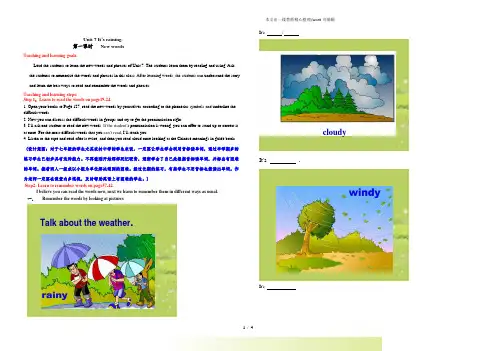
Unit 7 It ’s raining. 第一课时 New wordsTeaching and learning goals:Lead the students to learn the new words and phrases of Unit 7. The students learn them by reading and using. Ask the students to memorize the words and phrases in this class. After learning words, the students can understand the story and learn the best ways to read and remember the words and phrases.Teaching and learning steps:Step 1:Learn to read the words on page19-24.1. Open your books to Page 127, read the new words by yourselves according to the phonetics symbols and underline the difficult words.2. Now you can discuss the difficult words in groups and try to get the pronunciation right.3. I ’ll ask one student to read the new words. If the student’s pronunciation is wrong, you can offer to stand up to correct it at once. For the most difficult words that you can’t read, I ’ll teach you.4. Listen to the tape and read after it twice, and then you read aloud once looking at the Chinese meanings in guide book . (设计意图:对于七年级的学生尤其农村中学的学生来说,一定要让学生学会利用音标读单词,通过半学期多的练习学生已初步具有这种能力。
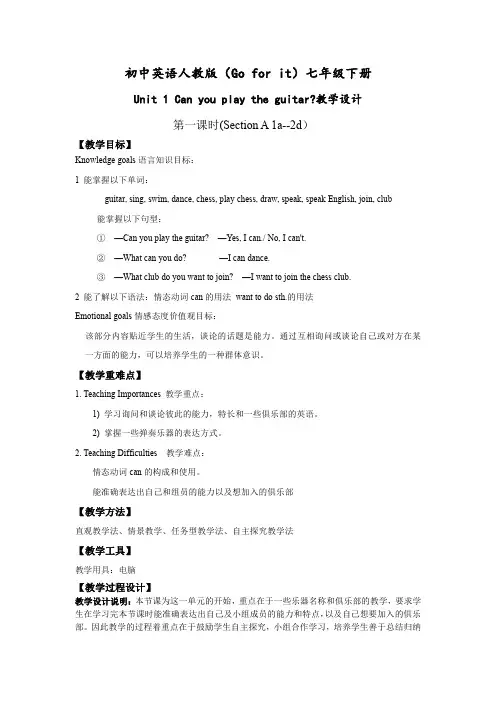
初中英语人教版(Go for it)七年级下册Unit1Can you play the guitar?教学设计第一课时(Section A1a--2d)【教学目标】Knowledge goals语言知识目标:1能掌握以下单词:guitar,sing,swim,dance,chess,play chess,draw,speak,speak English,join,club能掌握以下句型:①—Can you play the guitar?—Yes,I can./No,I can't.②—What can you do?—I can dance.③—What club do you want to join?—I want to join the chess club.2能了解以下语法:情态动词can的用法want to do sth.的用法Emotional goals情感态度价值观目标:该部分内容贴近学生的生活,谈论的话题是能力。
通过互相询问或谈论自己或对方在某一方面的能力,可以培养学生的一种群体意识。
【教学重难点】1.Teaching Importances教学重点:1)学习询问和谈论彼此的能力,特长和一些俱乐部的英语。
2)掌握一些弹奏乐器的表达方式。
2.Teaching Difficulties教学难点:情态动词can的构成和使用。
能准确表达出自己和组员的能力以及想加入的俱乐部【教学方法】直观教学法、情景教学、任务型教学法、自主探究教学法【教学工具】教学用具:电脑【教学过程设计】教学设计说明:本节课为这一单元的开始,重点在于一些乐器名称和俱乐部的教学,要求学生在学习完本节课时能准确表达出自己及小组成员的能力和特点,以及自己想要加入的俱乐部。
因此教学的过程着重点在于鼓励学生自主探究,小组合作学习,培养学生善于总结归纳知识,善于反思的品质。
设计主线为:新学期学校俱乐部招新,欣赏学生才艺展示。

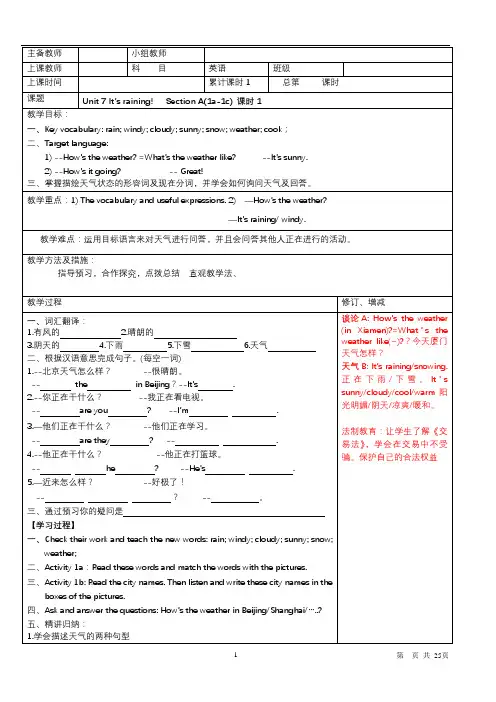
七年级(下)第7单元第3课时Unit7 It’s raining!Section B (1a-1e)七年级(下)第7单元第4课时Unit 7 It’s raining!Section B(2a-3c)七年级(下)第7单元第5课时Unit 7 It’s raining!Self checkUnit 7 It’s raining! Self check四、【教后反思】九年级英语上册期末试卷学校____________________ 姓名__________________ 准考证号__________________听力理解(共30分)一、听对话,从下面各题所给的A、B、C三个选项中选择与对话内容相符的图片。
每段对话你将听两遍。
(共5分,每小题1分)1.A.B. C.2.A.B.C.3.A.B. C.4.A.B.C.5.A.B.C.二、听对话或独白,根据对话或独白的内容,从下面各题所给的A、B、C三个选项中选择最佳选项。
每段对话或独白你将听两遍。
(共15分,每小题1.5分)请听一段对话,完成第6至第7小题。
6. What day is better for the boy to do sports?A. Monday.B. Tuesday.C. Wednesday.7. What sport does the boy like?A. Volleyball.B. Basketball.C. Tennis.请听一段对话,完成第8至第9小题。
8. What are the speakers mainly talking about?A. School life.B. Family members.C. People at the party.9. What is Jenny like?A. She is friendly.B. She is boring.C. She is quiet.请听一段对话,完成第10至第11小题。
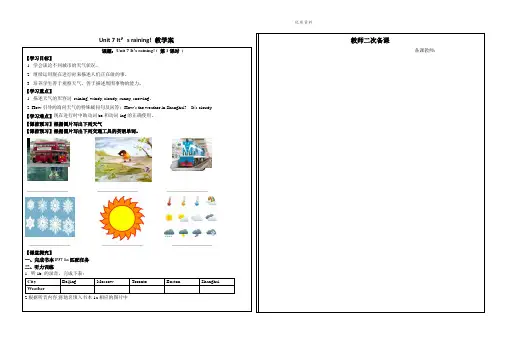
Unit 7 It’s raining! 教学案课题:Unit 7 It’s raining! ( 第1课时)【学习目标】1. 学会谈论不同城市的天气状况。
2. 继续运用现在进行时来描述人们正在做的事。
3. 培养学生善于观察天气,善于描述周围事物的能力。
【学习重点】1. 描述天气的形容词raining, windy, cloudy, sunny, snowing。
2. How引导的询问天气的特殊疑问句及回答:How’s the weather in Shanghai? It’s cloudy.【学习难点】现在进行时中助动词be和动词-ing的正确使用。
【课前预习】根据图片写出下列天气【课前预习】根据图片写出下列交通工具的英语单词。
_________________ _________________ __________________________________ _________________ _________________【课堂探究】一、完成书本P37 1a匹配任务二、听力训练1. 听1b 的录音,完成下表:City Beijing Moscow Toronto Boston ShanghaiWeather2.根据听音内容,将地名填入书本1a相应的图片中教师二次备课备课教师:三、快速阅读2d,思考以下问题:1.Are they talking face to face(面对面)or talking on the phone?2. Who does Steve want to talk to?四、再读一遍2d,回答以下问题:1.How is the weather?__________________________________________________________________2.What is Steve doing?__________________________________________________________________3.What is Rick’s brother doing?___________________________________________________________4.What does Steve want Rick to do?_______________________________________________________五、小组活动:谈论下列图画,并写下对话例:A: How’s the weather in Shanghai? B: It’s sunny.Beijing TorontoMoscow Boston二、用括号内动词的正确形式填空1. Tom and his father _________________(swim)now.2. Look! Mary _________________(run) with her father.3. We _________________(practice)the piano every evening .4. I ______________ (get) up at six and ________________ (have) my breakfast at about six thirty then I_______________ (go) to school at seven every day.5. We often __________________ (play) basketball on weekends.6. Keep quiet. Father _________________ (sleep) now.7. --What is Ann ____________ (do) ?-- She ________________ (do) her homework.8. -- _________________Nancy _________________(talk) on the phone?-- No, she isn't. She _________________(eat) lunch now.【家庭作业】____________________________【学后反思】________________________________________课题:Unit 7 It’s raining! ( 第2课时)【学习目标】1.继续练习谈论天气状况raining /windy/cloudy/sunny/snowing。
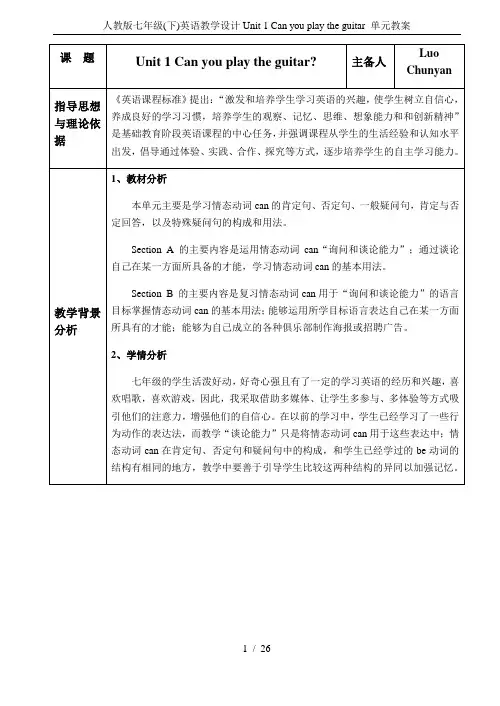
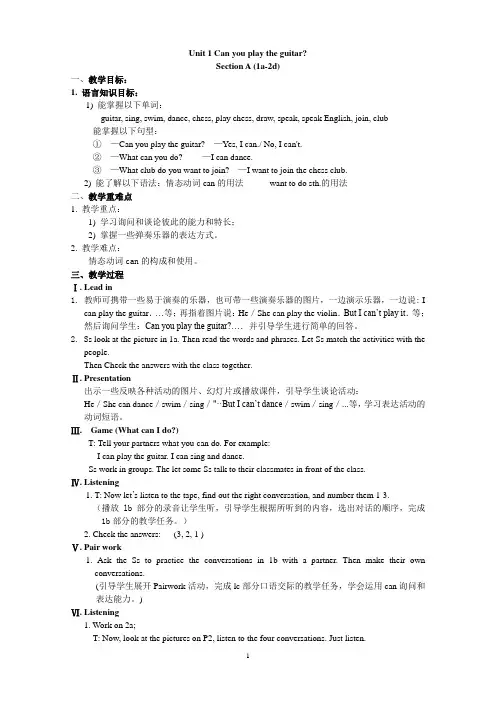
Unit 1 Can you play the guitar?Section A (1a-2d)一、教学目标:1. 语言知识目标:1) 能掌握以下单词:guitar, sing, swim, dance, chess, play chess, draw, speak, speak English, join, club能掌握以下句型:①—Can you play the guitar? —Yes, I can./ No, I can't.②—What can you do? —I can dance.③—What club do you want to join? —I want to join the chess club.2) 能了解以下语法:情态动词can的用法want to do sth.的用法二、教学重难点1. 教学重点:1) 学习询问和谈论彼此的能力和特长;2) 掌握一些弹奏乐器的表达方式。
2. 教学难点:情态动词can的构成和使用。
三、教学过程Ⅰ. Lead in1. 教师可携带一些易于演奏的乐器,也可带一些演奏乐器的图片,一边演示乐器,一边说: Ican play the guitar.…等;再指着图片说:He/She can play the violin.But I can’t play it.等;然后询问学生:Can you play the guitar?….并引导学生进行简单的回答。
2. S s look at the picture in 1a. Then read the words and phrases. Let Ss match the activities with thepeople.Then Check the answers with the class together.Ⅱ. Presentation出示一些反映各种活动的图片、幻灯片或播放课件,引导学生谈论活动:He/She can dance/swim/sing/"··But I can’t dance/swim/sing/...等,学习表达活动的动词短语。

第7单元It’s raining!类别课程标准要求掌握的内容话题The weather 天气Section A 单词rain v.下雨n.雨水windy adj.多风的cloudy adj.多云的sunny adj.晴朗的snow v.下雪n.雪weather n.天气cook v.做饭bad adj.坏的;糟的park n.公园message n.信息;消息him pron.他(he的宾格)could modal v.能;可以back adv.回来;回原处problem n.困难;难题again adv.再一次;又一次Moscow 莫斯科Toronto 多伦多Boston 波士顿短语ake a message 捎个口信;传话call (sb.) back (给某人)回电话no problem 没问题have a good time 玩得开心right now 此刻;马上句型1.—How’s the weather? 天气怎么样?—It’s cloudy. /It’s sunny. /It’s raining. 多云。
/ 晴朗。
/ 正在下雨。
2.—How’s it going? 近来可好?—Great! / Not bad. /Terrible! 好极了!/ 还不错。
/ 糟透了!句型1. I’m having a great time visiting my aunt in Canada. 我在加拿大看望我的姑妈,并且玩得很开心。
2. My family and I are on a vacation in the mountains. 我和我的家人正在山里度假。
3. It’s hot in your country now, isn’t it ?你们的国家现在很热,对吗?4.The weather here is cool and cloudy, just right for walking.这儿的天气凉爽且多云,正适合散步。
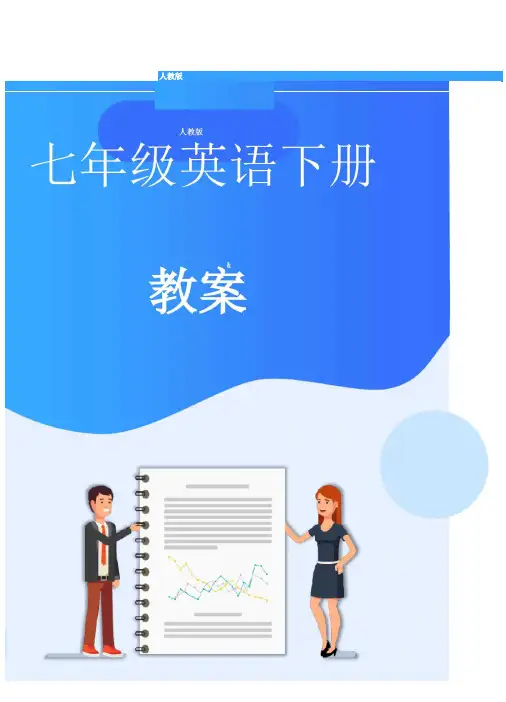

人教版(go for it)七年级下册第七单元Section B第一课时教学设计一、教学课型:听说课(45分钟)本课是人教版《英语新目标》(go for it)七年级下册第七单元Section B第一课时1a-2c 的内容。
二、教材分析1.教学内容:Unit 7 What does he look like? Section B(1a-2c)2.教材处理新课程标准强调语言教学应从学生的兴趣、生活经验和认知水平出发,倡导体验、实践、合作与交流的学习方式。
本套教材采用任务型教学(Task- Based Language Teaching)模式,即直接通过课堂教学让学生用英语完成各种真实的生活,学习,工作等任务,将课堂教学的目标真实化,任务化,从而培养学生运用英语的能力。
本节课是Section B的第一课时,学生已在上一课时中接触了本课的基础语言。
因此本人根据自己对教材的理解,紧扣课文主题设计了几个任务。
在任务前,先以头脑风暴的形式让学生快速回忆所学的描述人的词汇并拓展少量词汇,然后进行对话复习Section A的基础语言,为以下的任务打好词汇和语言基础。
根据教材中1b对明星简单的描述,设计出一个结对活动,通过观看两个影片来考验学生们的记忆以及对本单元基础语言的运用能力,让学生在感兴趣的话题中运用目标语言,给他们一个充分发挥自己创造力和合作、交流的空间。
通过section B 中的听力练习,设计出任务二:Guessing game。
这一活动既启发学生思维,让学生将所学的知识与自己喜欢的明星相结合,又使学生在运用语言同时,感觉到有乐趣。
最后在以上任务的基础上设计出描述家中某一成员并且要成文这一家庭作业。
3. 教学目标(1) 知识目标:熟练掌握重点句型:①What does he look like ?He is ……He has ……He is of ……②What does she look like ?She is ……She has ……She is of ……学习一些新的词汇:beard. glasses. have a beard, wear glasses, shabby(破旧的) , regular features(五官端正)……(2) 能力目标:运用所学的句型和词汇,描述人的外貌并且学会把所给信息汇成小文章.(3)情感目标:1. 能激发学生在今后日常生活中用所学的英语表达来谈论自己喜欢的明星.2. 通过几个任务对不同的人的描述,培养学生细心观察的好习惯.4. 教学重点和难点①询问他人外貌用语What does he look like?What does she look like?What do they look like?②描述他人外貌用语He/She is tall/ …… .He/She has short hair/…… .He/She is of medium height/…… .三,教学设计1. 总体思路本节课是Section B第一课时听说课,学生已在Section A中接触了本课的基础语言,因此本课重点培养学生口头运用语言的能力。

人教版7年级下册英语第七单元课文Unit 7: Our Earth, Our HomeLesson 1: Earth, Our HomeOur Earth is a beautiful and precious planet. It is the only planet known to support life. The Earth provides us with everything we need to live - air to breathe, water to drink, and food to eat. It is important that we take care of our planet so that it can continue to provide for us and for future generations.One of the biggest threats to our planet is pollution. Pollution comes in many forms, such as air pollution, water pollution, and soil pollution. Air pollution is caused by the emissions from vehicles and factories, which release harmful substances into the atmosphere. Water pollution is caused by the dumping of waste and chemicals into rivers, lakes, and oceans, which can harm marine life and make water unsafe to drink. Soil pollution is caused by the use of pesticides and fertilizers, which can contaminate the soil and harm plants and animals.To help protect our planet, we can take simple actions in our daily lives. We can reduce, reuse, and recycle to minimize waste and reduce our carbon footprint. We can also useenergy-efficient appliances and cars to save energy and reduce our emissions. By making small changes in our habits, we can all do our part to protect the Earth.In addition to pollution, deforestation is also a major threat to our planet. Deforestation is the clearing of forests for agriculture, logging, and development. This destroys the habitats of many plants and animals, leading to a loss of biodiversity. Deforestation also contributes to climate change, as trees absorb carbon dioxide from the atmosphere and help to regulate the Earth's temperature.To combat deforestation, we can support organizations that work to protect forests and wildlife. We can also plant trees in our communities and participate in tree-planting initiatives. By working together, we can help to preserve our forests and protect the biodiversity of our planet.In conclusion, our Earth is our home, and it is up to us to take care of it. By being mindful of our actions and making responsible choices, we can help to protect our planet for ourselves and for future generations. Let's work together to create a sustainable and healthy environment for all living beings on Earth.。
人教版七年级英语下册Unit 7集体备课教案教学目标:学生能够熟练掌握并应用与购物相关的基本词汇和句型。
通过情境模拟,培养学生的口语交际能力,提高其在实际场景中运用英语的能力。
培养学生的团队协作与沟通能力,通过小组活动增进彼此之间的了解与信任。
帮助学生了解中西方购物文化的差异,培养其跨文化交际的意识。
教学内容:购物相关词汇:如“price”、“discount”、“bargain”等。
购物常用句型:“How much does this cost?”、“Can you give me a discount?”等。
情境模拟:模拟购物中心、超市或网店的购物场景,进行角色扮演。
教学难点与重点:重点:购物词汇的准确运用,如“How much does this cost?”与“How much is it?”的区别。
难点:如何引导学生理解并运用中西方购物文化的差异,如砍价在中国的普遍性。
教具和多媒体资源:投影仪,用于展示购物词汇和句型。
角色扮演道具,如购物篮、商品模型等。
教学软件,用于模拟购物情境。
教学方法:激活学生的前知:通过提问学生平时购物的经历,激活其已有的生活经验。
教学策略:情境模拟与小组讨论相结合,使学生更好地融入语境,理解并运用所学知识。
学生活动:小组内进行角色扮演,模拟购物场景,并进行全班展示。
教学过程:导入:故事导入。
分享一个关于中西方购物文化差异的小故事,引起学生的兴趣。
讲授新课:通过投影展示购物相关的词汇和句型,进行讲解和示范。
之后进行情境模拟的介绍和指导。
巩固练习:小组内进行情境模拟练习,随后邀请几组学生进行全班展示。
归纳小结:总结本节课学习的重点内容,回顾购物相关的词汇和句型,强调中西方购物文化的差异。
评价与反馈:设计评价策略:观察学生在情境模拟中的表现,通过口头反馈和小组报告的方式进行评价。
反馈:针对学生在情境模拟中的表现给予具体、有建设性的反馈,指导其如何更好地在实际场景中运用英语。
七年级英语下册教案篇一:2022人教版七年级下册全册英语教案英语七年级(下)教案一、【教学目标】(一)语言知识1.词汇掌握wake,early, first,day, term,must,still,by,onfoot,the same to,usually,always,Ms.,boat,ship,sea,train,by plane/air/airplane, etc.2.理解Subway Worm reporter,Net Bar,roller skating Measuredining hall,dormitory bookstore,etc. (二)语法1.一般现在时(Simple present)2.频度副词(Adverbs of frequency)never, seldom, sometimes,often, usually, always, once, twice3.现在进行时(Present continuous) a. I’m looking for a book.b. Are you doing your homework? Yes, I am./No, I’m not.c. Is he/she...?Yes, he/she is. /No, he/she isn’t.d. What are you doing now? I’m playing computer games.e. What is he/she doing? He/She is...4.谈论交通方式(Talking about means of transportation) How do you usually go to school? I usually go to school by bike. (三)功能用语与话题1.采访(Interviews)Our guest today is Michael from Class 2, Grade 1.2.谈论日常生活(Talking about routines)3.学校建筑(School buildings)swimming pool, playground,library, dormitory, lab, gym4.谈论兴趣喜好(Talking about interests, likes and dislikes)I like the swimming pool best. Why do you like English? Because it’s interesting and easy. 5.借物(Borrowing things)How long can I keep it? Two weeks. 6.新闻(News)、海报(Poster)Attention,please! Here is the news.7.谈论学校活动、科目和时间表(Talking about school activities,subjects and timetable) 8.谈论学校生活(Talking about school life)(四)能力培养【听】能听懂谈论校园生活中比较熟悉的话题,识别主题,获取主要信息。
unit7.1七下第七单元专题7.1SectionA-七年级英语⼈教版(下册)Unit 7 It’s raining!课标单词 1.rain(v.&n.) ________________________2.windy(adj.) ________________________3.cloudy(adj.) ________________________4.sunny(adj.) ________________________5.snow(v.&n.) ________________________6.weather(n.) ________________________7.cook(v.) ________________________8.bad(adj.) ________________________9.park(n.) ________________________10.message(n.) ________________________11.back(adv.) ________________________12.problem(n.) ________________________13.again(adv.) ________________________14.dry(adj.) ________________________15.cold(adj.) ________________________16.hot(adj.) ________________________17.warm(adj.) ________________________18.visit(v.) ________________________19.Canada(n.) ________________________20.summer(n.) ________________________21.sit(v.) ________________________22.juice(n.) ________________________23.soon(adv.) ________________________24.vacation(n.) ________________________25.hard(adv.&adj.) ________________________26.Europe(n.) ________________________27.mountain(n.) ________________________28.country(n.) ________________________29.skate(v.) ________________________30.snowy(adj.) ________________________31.winter(n.) ________________________32.Russian(adj.&n.) ________________________33.snowman(n.) ________________________34.rainy(adj.) ________________________⽬标短语 1.have a good time________________________2.take a message________________________3.sound like________________________4.call sb.back ________________________5.right now________________________6.have fun________________________7.(be) on a vacation________________________常考句型 1.—How’ s the weather?—It’ s raining./It’ s sunny .2.—How’ s it going?—Great!/Not bad./Terrible!3.—What are they doing?—They’ re playing basketball in the park.重点语法 1. —How’s the weather in Shanghai?—It’s cloudy.2. Sounds like you’re…3. Could you just tell...?【答案】课标单词: 1.下⾬;⾬⽔ 2. 多风的 3. 多云的 4. 晴朗的 5. 下雪;雪6. 天⽓7. 做饭8. 坏的;糟的9. 公园10. 信息;消息11. 回来;回原处12. 困难;难题13. 再⼀次;⼜⼀次14. ⼲燥的15. 寒冷的;冷的16. 热的17. 温暖的18. 拜访;参观19. 加拿⼤20. 夏天;夏季21. 坐22. 果汁,饮料23. 不久;很快24. 假期25. 努⼒的,困难的26. 欧洲 27. ⾼⼭28. 国;国家29. 滑冰30. 下雪的31. 冬天;冬季32. 俄罗斯的;俄罗斯⼈;俄语33. 雪⼈34. 阴⾬的;多⾬的⽬标短语: 1. 玩得开⼼ 2. 捎个⼝信 3. 听起来像4. 给某⼈回电话5. ⽴刻,马上6. 玩得开⼼7. 度假Point 1 rain 下⾬rain动词,意为"下⾬"。
Unit 7 It’s raining第1课时关店中学:胡一、学习目标1.掌握单词: rain, windy, cloudy, sunny, snow, weather, cook, study, bad, terrible, pretty句型: How’s the weather in Shanghai" It’s cloudy. What are you doing" I’m watching TV.2.学会谈论天气及描述你正在做的事;3.表达对天气的喜好并说明原因,学会使用现在进展时描述人们正在做的事。
二、学习重点1.掌握单词: rainy、windy、cloudy 、sunny 、snowy、weather2.重点句型:- How’s the weather in Shanghai" - It’s cloudy.- What are you doing" - I’m watching TV.三、学习过程〔一〕课前准备预习导学及自测1.预习p31生词,做到会读知意。
2.认知城市名称。
3.探究发现:表天气的名词如何变成形容词?完成以下单词多雨的_____多雪的_______有风的_______ 阴天的________晴朗的____cook(现在分词) ________study(单数第三人称)_________糟糕的_________(二)课堂活动Step1 情境导入1.Do1a. Look at the pictures and match the words with the pictures in small groups.2. 看图听1b的录音,把地名填入图中的方框里;3. 自我练习1c,根据上边的每图进展问答:Step2自主探究1. Summary:(1) 询问天气情况:_____________________ / ____________________"(2) 询问*人正在干什么:_____________________________________"2. Do2a .Listen and number (1-4) the pictures as you hear them.Listen again and match the names with the activities.Step 3合作交流1. Do3a. Match the words with the faces in the bo*.2. Do3b. Pairwork.3. Talk about the weather with your friends in groups.Step 4课堂点拨1. How’s the weather" =What’s the weather like "都是用来询问天气状况的句型。
Unit 7 It’s raining.Section A (1a-2d)一、教学目标:1. 语言知识目标:1) 能掌握以下单词:rain, windy, cloudy, sunny, snow, weather, cook, bad, park,message, take a message, could, back, problem 能掌握以下句型:①—How's the weather in Beijing?—It's sunny.②—Can I take a message for him?—Yes. Could you just tell him to call me back?—Sure, no problem.2) 能用所学的知识描述天气情况。
3)描述正在发生的动作。
2. 情感态度价值观目标:教育学生善于观察天气,善于调整自己的情绪;了解世界各地的天气情况,增加世界观念。
知道大自然的力量是神奇而伟大的,我们应当好好学习,立志学好科学知识,为长大后探索神奇的大自然,打好基础。
二、教学重难点1. 教学重点:1) The vocabulary and useful expressions.2) —How’s the weather?—It's raining/ windy.3) —What are you doing?—I'm playing basketball.2. 教学难点:运用目标语言来对天气进行问答,并且会问答其他人正在进行的活动。
三、教学过程Ⅰ. Warming-up and Lead in1. Greet the Ss and check the homework.2. Watch a video program about the weather.Ⅱ. Presentation1. (Show some pictures of the weather)Let Ss look at the pictures and ask them how the weather is.Ss learn the new words and expressions with the help of the pictures.2. Look at the pictures in 1a. Then read the new words on the right. Ask the Ss tomatch the words with pictures.3. Check the answers.Ⅲ. Game (How's the weather?)1. (Showing some pictures on the big screen.) Ask Ss "How's the weather?"2. Ss guess and answer the question.Ⅳ. Listening1. Now let's look at the city names in the box in 1b. Please read after me.Ss read the cities after the teacher.2. Now, We’ll hear four conversations. Listen carefully, point out each city in thepicture as it comes upon the tape. Play the recording a second time. Ask Ss to write the name of the city in the picture of its weather.3. Check the answers.Ⅴ. Pair work1.Tell the Ss: If you are in one of the places in the picture above. Talk about theweather with your friends in another city on the phone.2. Make a model with a student like this:T: Hi! How's the weather in Beijing?S1: It's sunny.3. Ss work in pairs. Ask and answer about the weather in the cities.Ⅵ. Listening1. Work on 2a.Let's see what Joe's families are doing. Point to the 4 pictures.2. Ask Ss tell each person is doing in each picture. More attentions should be paidto the correct use of the Present Progressive Tense.3. Play the recording for the Ss to listen and number the pictures [1-4].4. Play the tape for Ss to check the answers.5. With the whole picture, get some Ss to tell the story of it.6. BrainstormingPlay the tape for another time. Then do a memory test.Ask Ss: What's Uncle Joe/Jeff/Mary/Aunt Sarah doing?What're Scott and Lucy doing?Is Jeff watching TV? etc.7. Let Ss match the names with the activities in 2b.Play the recording for the Ss to check the answers.Ⅶ. Pair work1. Look at the pictures and talk about the people in 2a with a partner.2. Ask a student the questions as a model:T: What's Uncle Joe doing?S1: He's playing basketball.3. Ss work in pairs. Ask and answer about the pictures.Ⅷ. Role-play1. Ask Ss to read the conversation and answer the questions:①What's Steve doing?②What's Rick's brother doing?Ss read the conversations and answer the questions. Then check the answers together.2. Let Ss role-play the conversation in pairs.IX. Language points.X. ExercisesHomework:一、总结有关天气的词汇。
七年级下复习教案
大单元教学设计一,单元内容分析(课标分析)
二,单元教学目标
三,学情分析
总复习阶段,学生的态度总体较为积极。
绝大多数学生对英语总复习持有较高的兴趣和主动学习态度。
他们愿意参与课堂活动,并愿意主动与教师和同学进行交流。
然而,也有一部分学生对英语复习缺乏热情,需要教师的教育和激励,大部分学生的英语整体水平较为均衡。
大多数学生能够熟练掌握基本的英语语法和词汇,并能够进行简单的听说读写。
然而,仍有一部分学生的英语水平相对较低,需要额外的支持和指导。
四,教学要点和课时安排
单元分课时设计
单元分课时设计
单元分课时设计。
An Open Class for Grade 7Go for it(The 1st period of Unit 7, Book 1B)ByPlace: Class 1, Grade 7School:Central SchoolDate: April 17, 2012Unit 7 What does he look like?The First PeriodⅠ. Teaching aims and Demands1. Knowledge Objects1).Main Words: hair, height,build,short, tall, medium, thin, heavy, curly, straight2).Main Phrases : straight hair, of medium height, of medium build, look like3).Main Sentence Structures:-What do you look like?- I’m short.I’m thin.- What do they look like?- They’re of medium height.- What does he look like?- He is of medium build.- What does she look like?- She is tall. She has curly hair.2. Ability Objects1).Students can use English to describe people well, and can draw the person they say.2).Students can guess the person according to others’ description.3).They can master the main words and phrases in this class anduse them to write their own passages.3. Moral Object1).While discussing with others, students should know how to describe others and learn to respect others.2).Teach students to learn to praise others in a good way and tryto find the advantages of others.3).Learn to appreciate others and know that having a beautiful soul is better than being good-looking. Never judge from appearances.Ⅱ. Teaching important Points1).Learn to use the main words and the sentences to describe others.2). Learn the differences between “has/ have”and “is/are”.Ⅲ. Teaching Difficult Points1).Train the students’ listening and speaking skills.2). Learn to describe people.Ⅳ. Teaching MethodsScene teaching method. Practicing method. Co-operation method.Ⅴ. Teaching AidA computer.Ⅵ. Teaching Procedures:Step1:Lead-in1. Greet the students as usual.2. Show a photo of mine ,describe myself and help students toin Book1A. Lead them to say something review “My ID card”more about people.Step2 :New words1. Show some words that describe people and then ask some students to say the meanings. Then practice reading the words.2. Show some cartoons and pictures, help students to practice describing people’s “hair”. Then talk about people’s “height”.Finally, help students to practice describing people’s “build”.Step3: 1aAsk the students to match the words with the people inthe picture and then check the answers.Step4: 1b1. Have the students listen and fill in the blanks in the picture and then check the answers.2. Get the students to find Amy’s friend in the picture and then check the answer.Step5: 1c Pairwork:1. Ask two students to read the sample conversation.2. Get the students to work in pairs.3. Ask some pairs to present their conversations.Step6: 2aattention to the numbered list of phrases.1. Call students’2. Play the recording. Get the students to listen and circle“is”and “has”.3. Check the answers.Step7 : 2b1. Point to the headlines “is”and “has”and the sample answer.2. Get the students to listen and write the descriptions of Sally and Pete in the chart.3. Play the tape. Students fill in the chart.4. Check the answers.Step8: 3 Pairwork1. Point to the girl in the bubble.Invite a couple of students to describe her.2. Ask a couple of students to read the conversation. Get the students to complete the conversation with the description words.Step9: Grammar focus1. Have the students read the questions and answers in pairs.2. Explain some language points.Step10: SummaryIn this class,we ’ve practiced describing people with some main words and sentences(what questions).We should try to find the advantages of others and learn to respect people. Remember :never judge from appearances.Step11: Homework1. Copy the new words in Page111.2. Guessing game. Describe one of your friends. Then let other students guess who he/she is?3. Write a passage ab out “My favorite star ”. Blackboard design:Teaching reflection: Unit7 What does he look like?tall / short / heavy / thin- What do you look like? be+- I ’m short. I ’m thin.of medium height /of medium build- What does he look like? short / long hair- He is of medium build. have/has + straight /curly hair- What does she look like? big / small eyes/nose -She is tall. She has curly hair.。